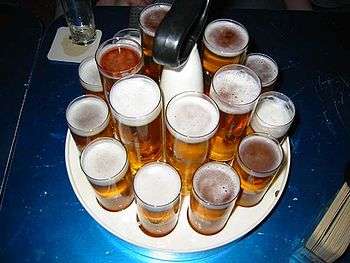Beer in Italy
Italy is considered to be part of the wine belt of Europe. Nevertheless, beer, particularly mass-produced pale lagers, are common in the country. It is traditionally considered to be an ideal accompaniment to pizza; since the 1970s, beer has spread from pizzerias and has become much more popular for drinking in other situations.[1]

In the seventh century BC in Sicily, the Phoenicians traded and consumed beer. In Piedmont, Pombia, Province of Novara, an archaeological investigation found tombs from the Golasecca culture, including a tomb from 560 BC containing traces of beer.[2] Ancient Rome knew of beer and produced small amounts, but the systems of production were destroyed in various barbarian invasions.[3] The first medical school, the Schola Medica Salernitana, praised the substance stating that it "supports old age, flows through the veins, increases well-being, and strengthens the blood."[4]
On the occasion of his wedding, Ludovico Sforza distributed beer freely to the Milanese. At this time, it was referred to in Florence as "barley wine".[5] The first brewery in Italy, according to Hermes Zampollo, was "Spluga" in Chiavenna, which opened in 1840. However, the company Wührer stated that its brewing commenced in Brescia in 1829.[1] The first person in Italy to cultivate hops for beer brewing was Gaetano Pasqui in 1847.[6] In 1983, the country consumed 12 million hectoliters of beer.[7] As of 2010, Italy has a beer consumption of 30 litres per capita per year.[8]
Breweries and brands
One of the oldest and most widespread breweries in Italy is Peroni, today owned by the Asahi group, which also owns the popular brand Nastro Azzurro.[1] Other known breweries and beer brands are:[1]
- Beba
- Birra del Borgo (owned by InBev)
- Birra Raffo (owned by Asahi)
- Birrificio Baladin
- Birrificio Italiano
- Castello
- Dreher (owned by Heineken)
- Forst
- Ichnusa (owned by Heineken)
- Menabrea (owned by Forst)
- Birrificio Dr. Barbanera
- Birra Messina (owned by Heineken)
- Birrificio Lambrate
- Birra Morena
- Moretti (owned by Heineken)
- Opperbacco
- Birra Pedavena (owned by Castello)
- Peroni (owned by Asahi)
- Poretti (owned by Carlsberg)
- Birra Semedorato
- Toccalmatto
- Theresianer
References
- Michael Jackson (1998). Le birre: oltre 600 marche e produttori di tutto il mondo. Milan: Vallardi. p. 52. ISBN 9788882112073.
- Marco Cattaneo (2013). La bionda venuta da lontano. Milan.
- Michael Jackson (1998). Le birre: oltre 600 marche e produttori di tutto il mondo. Milan: Vallardi. p. 47. ISBN 9788882112073.
- Michael Jackson (1998). Le birre: oltre 600 marche e produttori di tutto il mondo. Milan: Vallardi. p. 48. ISBN 9788882112073.
- Michael Jackson (1998). Le birre: oltre 600 marche e produttori di tutto il mondo. Milan: Vallardi. p. 49. ISBN 9788882112073.
- Umberto Pasqui (2010). L'uomo della birra. Forlì: CartaCanta Editore.
- Michael Jackson (1998). Le birre: oltre 600 marche e produttori di tutto il mondo. Milan: Vallardi. p. 55. ISBN 9788882112073.
- "Beer Statistics, 2010" (PDF). Brauer-Bund. 2011. Retrieved 1 August 2015.
- Romanutti, Fabiana. "Birra artigianale friulana al Daniel di New York". qbquantobasta.it (in Italian). Retrieved 2019-07-17.
- Swanson, Alex. "How to Choose the Healthiest Beer | TheHealthBeat.com". Retrieved 2019-07-17.
- "La Birra di Meni sbarca a New York con l'alta cucina". www.ilgazzettino.it. Retrieved 2019-07-17.

